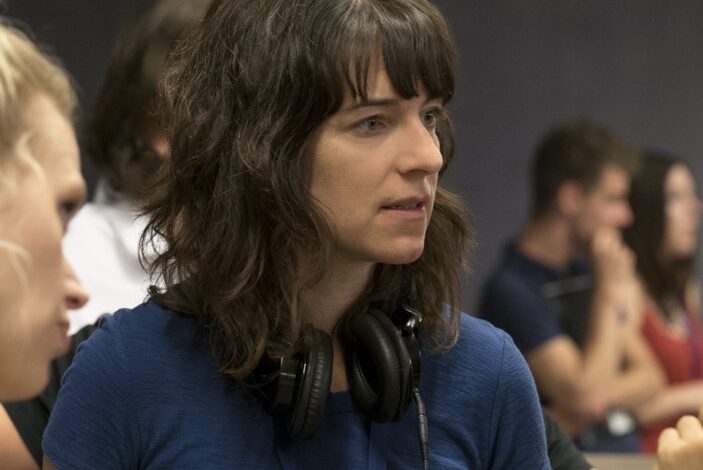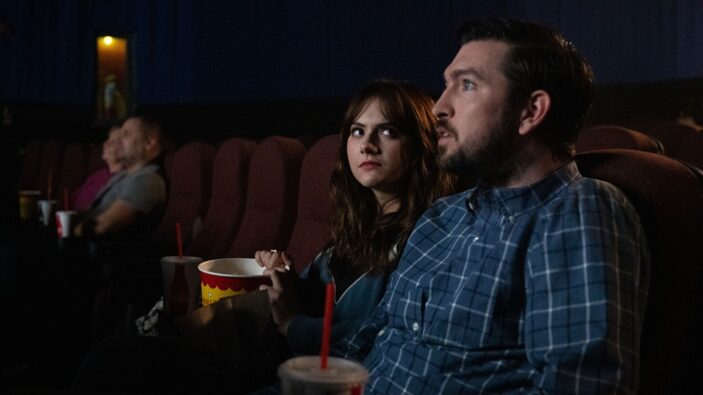
When Margot, a college sophomore, goes on a date with the older Robert, she finds that IRL Robert doesn’t live up to the Robert she has been flirting with over texts. Directed by Susanna Fogel (TV’s The Flight Attendant, The Spy Who Dumped Me), adapted by Michelle Ashford from the acclaimed New Yorker short story by Kristen Roupenian, Cat Person is a razor-sharp exploration of the gender divide, the quagmire of navigating modern dating, and the dangerous projections we make in our minds about the person at the other end of our phones.
To coincide the release of this 21st century dating distresser, Peter Gray spoke with Fogel about finding the balance of directing such a genre-bending thriller, the perfect casting of her intricate characters, and how she first heard of this fascinating story.
Was this a story you were familiar with prior to taking the film on? It wasn’t something I had ever heard of, so I appreciated watching the film without any preconceived notions.
The people that are responding to the movie in the most authentic way are the people who don’t know about the story (beforehand). I think there’s a tendency to – especially with a story that was as provocative as this – is to compare side by side. What’s the same? What’s different? I think that can take away from the viewing experience in a way, so I’d rather people just see it. But I also want people who know the story to be excited to see the movie (too). It’s a little bit of a paradox there.
Yeah, it was a story I was aware of. I’m a New Yorker reader. It (went) so viral that the reach (of “Cat Person”) went beyond the normal reach for a New Yorker story. And I think part of the reason it did is that the New Yorker…I still think that stories about young women’s experiences are often trivialised. They’re not usually put in fancy literary magazines that are for men and women. People of all ages. That’s not the usual forum where these stories get told. But there it was, sort of shoved in the faces of all these people who wouldn’t have paid attention to the story if were an essay. They were forced to deal with how provocative it was for them, and that led to a lot of debate.
I was aware of it as a cultural moment. And I loved the story. And that was great. I wasn’t sure how adaptable it was (because) it felt so small and contained. I thought this was going to be a small movie for five women at the IFC centre, it’s not going to really hit the culture in the same way, because it’s such an internal (story). Then I was sent the script a couple years later, and I saw how beautifully Michelle Ashford had expanded it into basically a thriller. I thought, “Okay, this is the way to do it!” As a result, it’s the version that, I think, will provoke people and make them debate. And I’m sure some people will hate it, and that’s what the story did. That’s what the movie does.
I was going to ask about you being a writer, because when you have a script like Michelle’s presented to you, do you look at it as something you’ll collaborate on further and possibly alter? Or it’s one of those things where you read it and you know you can’t possibly change it?
I direct a lot of television, and in television I come in and it’s really a writer’s medium. I know it’s not my job to change any dialogue. I’m used to shifting into that mode. I’ve had projects that I’ve directed where I do re-writing, if I feel it needs it, and there are other projects where I don’t. But I read Michelle’s script, and even though we talked about how to shape that third act together, she did all the writing. We talked about if (the story) was enough and if it was landing right, and she would go off and do the actual writing. I wasn’t involved in that way, which was really nice. (Michelle’s) so experienced and good at her job that she would come back with something amazing.
You mentioned before about how this story was moulded in this thriller aspect, but it also has that dark comedic streak, and comedy has always been something of a throughline in your projects. How do you find navigating those genre aspects?
On the TV side I had done a little of that. I worked on this show Utopia, which is a Gillian Flynn show. It’s very dark. It’s dark-forward comedy. And I directed the pilot of a series called The Flight Attendant, which was a murder mystery, so I had done some of that genre stuff before.
For (Cat Person), it’s like anything, it’s the balance. It’s selling a character. I like putting a funny character into a dramatic situation. It’s my favourite thing to do. I don’t want to write a movie about a women who takes everything so seriously. I think that humour is the quickest shortcut to someone connecting with a character and wanting to follow their journey. So if (the character of) Margot is sort of funny and gets the joke and has a good personality, it helps that you follow her. That way when she does something conspicuously naïve, you’re like “Argh, but you’re layered”, so you don’t want to leave this young woman. You feel connected to her and her mistakes.

On the mention of the characters themselves, I want to touch on the casting. I have to give a shout out to Geraldine Viswanathan first off as a fellow Australian. How did you go about assembling such a cast? Everyone is so perfectly tailored to their character. Did you have Emilia Jones and Nicholas Braun in mind?
I mean, to start with Geraldine for a second. I’m obsessed with her. She is one of those actresses I’ve been following for so long. I think she can do absolutely anything. I wrote her a fan letter, and I was like, “Please do this movie!” I was obsessed with her playing that part even before we knew who was going to play Margot. So we started with (Geraldine).
With Amelia and Nick, it was interesting because they’re both hard parts to cast for different reasons. You have to believe that she is college-aged, so you can’t cast a 30-year-old. I mean, you can, but then you’d have to cast a 50-year-old as Robert (laughs). I wanted someone that was that age because they look their age. Amelia was around 19, 20, so she was the age of Margot. It was also hard to find someone to play that role because with very famous young actresses, they have too much baggage culturally. (Audiences) like bringing their opinions into movies where the star is someone they see in tabloids. Amelia had this blank state. She had just done Coda, but it wasn’t out yet. I had seen it and I thought she was incredible.
And (the character of) Robert was interesting. If you read the original story it describes Robert as the kind of guy you could drum up a crush on if you were bored. Not the person you notice, but the person you could talk yourself into liking…
Oh my god, that’s such a perfect description of him!
It’s the perfect description. So my job is who do I think that is for people? I have to decide who that is for most viewers. It’s such a nuanced thing. You look at pictures of actors and some are too immediately pretty to be like that. You’re evaluating them on the most objectifying level because you have to fit a description. Nick (Nicholas Braun) is such a chameleon in that way. Nick is the person who can be in GQ, wearing an Armani suit and looking like a model, but because he’s 6 foot 7 he can be quite looming. And because depending how you frame him and light him, and how he’s behaving, he can seem like different people. And that’s what Robert seems to Margot. She’s piecing together the different sides of Robert into this amalgamation that makes sense of who he is.
Like when they’re in the therapy scene, he’s wearing the Knives Out sweater and he’s being adorable, and then other times he’s a horrifying giant man whose hand is the size of her face. (Nick) was so perfect for that part. And I think he really committed to it.
As soon as I saw the film I knew it would generate conversation, for better or for worse. And, as a reviewer, it’s always appreciated when I don’t know where the film is going, and this certainly went to places I wasn’t expecting…
Yes, totally. When it goes off the rails, I always mention Parasite as a comparison. That film starts off as this grounded observational movie about class, and then it becomes this insane, very real horror show. It’s those layers being peeled back for the genre. You ask “What just happened?” (With Cat Person) I wanted to establish the life of (Margot’s) subconscious, but also ask if everything is in her head. Her greatest fear sort of manifests itself in reality, but I wanted to leave you guessing what the hell you’re watching!
Cat Person is screening in Australian theatres from November 23rd, 2023.
